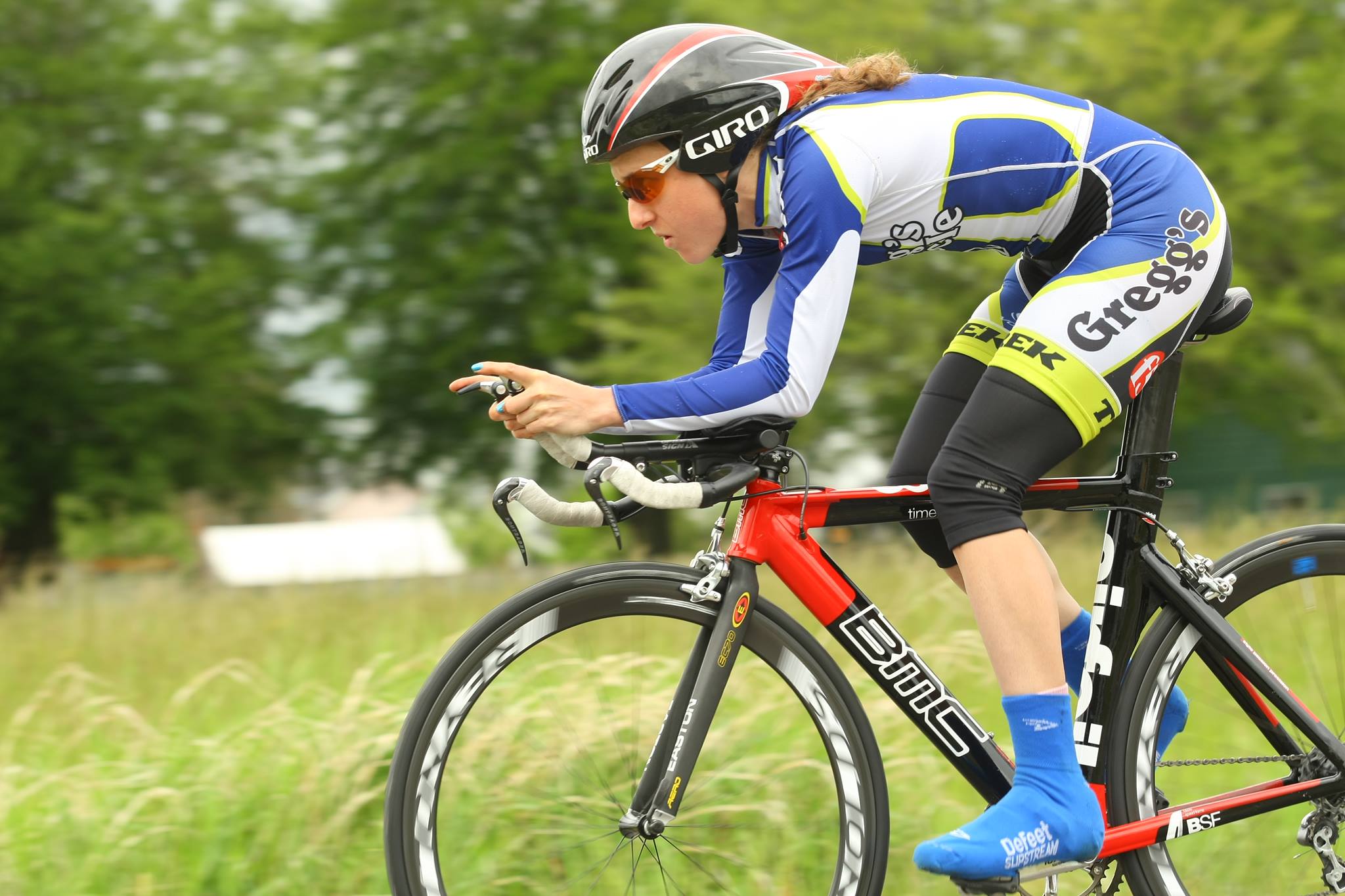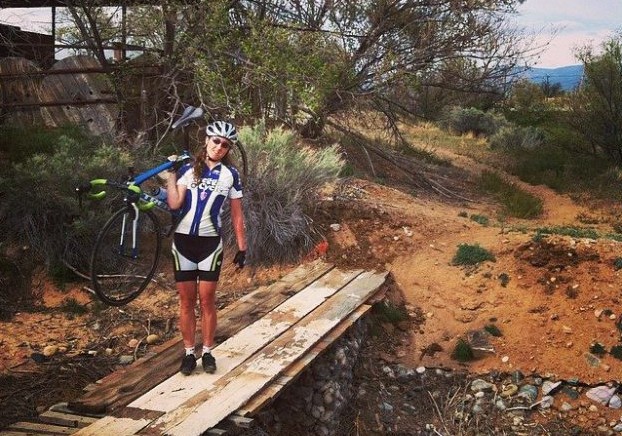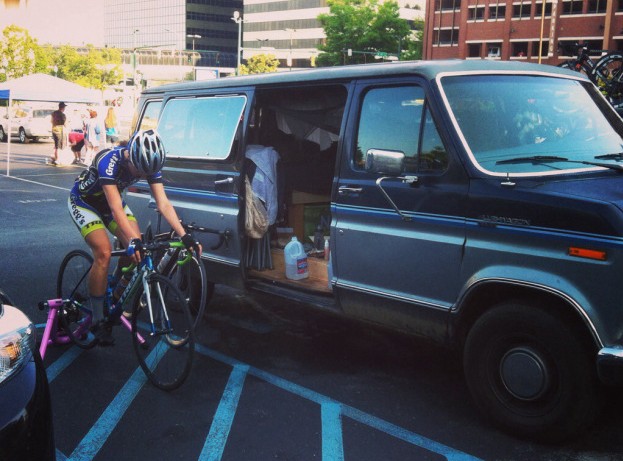
Kat Reinhart time trialing. Photo by Amara Edwards, Wheels in Focus.
The lions of professional sport often have a common narrative to their success: innate talent was discovered early and led to a meteoric rise to the top. But they represent a tiny percentage of the athletes in the pro peloton. For many if not most professional cyclists, however, the success story is one of hard work, struggle, perseverance, some failure enroute, and a whole lot of luck. Kat Reinhart falls squarely in that second path.
Reinhart is a Cat 2 road racer chasing a professional cycling dream. She spent most of the 2014 season living in a 1988 Ford Club Wagon van with her fiancee Nate (also a bike racer), traveling the country to race NRC races–the highest level professional women’s road races in the US. I sat down with Reinhart to talk about her first season racing in the pro peloton, the challenges of making it, the pros and cons of the dirt bag van life, and her cycling career endgame.
How is your first season of racing in the professional ranks going? What has it been like jumping into that level of racing?
This year has been my first attempt at racing at the national level, doing NRC events. Racing at the local level here, there’s a group of really strong women who are all about the same level. It’s a really great group of people. The competition is good, healthy, fun, but it’s always the same 10-16 people. It’s a bit of shock to go from racing with 10 people to racing with 60 people, so I’m trying to wrap my brain around how to deal with a peloton of that size.
This season I started off with some local races, then we moved into the van and drove down to the Tour of the Gila, which was my first NRC race. It’s a big race. United Health Care was there with a full squad. Mara Abbot won, Allison Powers was there. That team was so dominate. All of the other big teams were there, with a few exceptions. It was pretty intimidating lining up on the start line. Once the racing started I figured out that I was definitely not the weakest person there, I just needed to get my feet wet and learn to navigate the peloton.
At Gila, I finished the race, which is more than some people can say. It was a struggle. It was really hard. That was actually what drew us to Gila in the first place. It’s so gnarly: it’s at altitude, the roads are really exposed, there’s really technical descending. I knew it was going to be such a challenge. And it didn’t disappoint.
After Gila we went to Boulder for a while to train at altitude. It seemed silly to drive all the way back to Seattle then to Chattanooga, Tennessee for Nationals. We took two months off of work. I did a local race in Boulder–though any race there is going to be a stacked field. I pulled out a really good result in the time trial there. I got 3rd, which is probably the best result I’ve had in my career. Allison Powers won, I beat Flavian Oliveira and some other names on that list and was like, whoa, what!? That gave me confidence going into Nationals that I belonged there.
Nationals was my big goal for the year. I wanted to go and contest the time trial and see how I stacked up. I didn’t expect to do very well, but I wanted to see on the same day, on the same course, how my time compared to all these other people who I’ve been reading about and looked up to the last couple of years.
The TT at Nationals was really, really technical. It was not flat at all. It wasn’t really hilly so much as rolling, bumpy stuff. But there were a lot of roundabouts and roundabouts that you took at a weird angle cause you were on the wrong side of the street. There were things I’d never ridden my bike on and I struggled with picking the right line and braking too much and things like that.
I ended up 26th place in the TT. It was a little disappointing. It was about what I expected, but not as well as I hoped. I think I got some flak from friends for not seeming stoked about that. And I know it’s a good result, but if I was happy with 26th place, I wouldn’t be here.

Adventuring in Santa Fe. Photo by Nate Pitts.
How did you get your start in racing?
Going back to 2007 when I graduated from college, I bought a cyclocross bike. I had a friend from school noticed I was riding a bike and got me to come watch the Volunteer Park Crit in Seattle with him that year. I was like, whoa this is so cool, how do I get into this? I dabbled in a few cross races that fall and then did a few more the next year.
In 2009, I went to graduate school at University of Oregon and I joined the cycling team. That was a really good way to get into road racing. The collegiate scene is so welcoming. It’s smaller and easier to get into it as a student. University of Oregon team definitely deserves a lot of credit for getting me into racing.
But the grad school thing kind of got in the way. In the fall of 2010 I got the Swine Flu and I was trying to finish my quals and I was writing a grant and I should’ve been training more. Everything imploded on me. The strain of flu I got put me in bed for three weeks and I couldn’t properly digest food for the next four months. I couldn’t train that winter and my next year was pretty much a bust for racing. And I realized somewhere along the line that you can’t have it all. Some people in the peloton can, because they’re exceedingly focused, but for me I have to have one thing that I’m focusing on.
On that note, have you found it difficult to balance work and training and traveling for racing?
I work at Gregg’s Cycles in Seattle and it’s both great and terrible. It’s great because I can get off most of the time I need without a problem and I get good deals on equipment. I’m at the shop everyday surrounded by bikes and sharing my passion for bikes with other people, which is awesome. It kind of sucks because I’m competing with people who work at Microsoft and Amazon and Boeing. I don’t have the money to throw at the problem, I just have the time and the energy to put into it.
My managers have been really, really understanding. And I’ve kind of also put it in no uncertain terms that this is what I need to do. When I put in my request for two months off, my boss was kind of like “oh my god, are you kidding?” I put it as: this is my biological clock ticking. I’m 31, I’m not getting younger. I’ve never felt like age has held my back in my career. If you look at other women endurance athletes they tend to peak a lot later. I feel like I’m coming into my prime right now, but if I wasn’t doing what I’m doing right now I’d be letting opportunities and time slip away.
Was there a conscious choice at some point to try and make it to this level or was it just natural progression?
After my crappy season in 2010, I actually took a whole year off and didn’t even ride a bike, which is crazy to think about now since I ride every day, everywhere. I realized at the end of that year how unhappy I was without the bike and how it keeps me sane and focused on achieving my goals. That conscious decision happened at several points along the line.
It also happened when I started dating my now-fiancee, who’s also a bike racer. He’s got good sleeping habits, good eating habits, we’re really compatible in other ways. At that point when I was still just a Cat 4, I decided I was going to take it really seriously, train hard. I didn’t tell anybody my goal was to go pro, but that’s always been the goal. You can’t tell anyone that when you’re a Cat 4 cause they’re just going to laugh at you for not knowing how hard it’s going to be. I still probably don’t know how hard it’s going to be.

Kat Reinhart and her fiancee lived in a 1988 Ford Clubwagon. Photo by Nate Pitts.
How quickly did you go from there to where you are now?
From 4 to 3 was pretty easy. I just trained my butt off that winter and won every race I entered by riding away from everybody. The jump from 3 to 2 was more of a struggle. Here and in a lot of place women Cat 3s are put in with the 1-2s. You get your first license upgrade and all of a sudden you’re racing against pros. It wasn’t so much an issue of whether I was strong enough. I had definitely been putting in the work. It was about learning who these people are–like I said, it’s the same group of 10 people–wanting to be on good terms with them and not just be a sketchy rider. I was learning the unspoken rules of the road while also getting the results to get the 3 to 2 upgrade. This year I’ve been less focused on the results in local races. It sounds weird to say, but really have been focused more on just riding well in a peloton, being a safe rider, being a good sport. I haven’t had that many great results this year–lots of 7th places, 4th places, but it’s been a good learning experience.
Do you live in a van full time?
We just moved out of the van actually. We were kind of using it as a bedroom for the last couple of weeks since we got back from Nationals. My fiancee Nate’s aunt is an empty nester with extra bedrooms and she and her husband have been really, really welcoming of us. So we’re renting from relatives. We’re not living in the van anymore, sadly.
But probably not that sad, right?
It is nice to be able to stand up when you get out of bed.
What inspired you to move into a van in the first place?
Nate’s a big fan of the Dirtbag Diaries podcast, so there’s that. And I’m kind of obsessed with the tiny house movement. We’re not really at a point in our life where we can buy property and build a tiny house to live in. Buying a van seemed like a more accessible way to go.
When we were sitting down to plan our season last fall, we plotted out all the races we wanted to hit. Gila (in New Mexico), Nationals (in Tennessee), Cascade (in Oregon). Then we were like, how can we make this happen? Let’s buy a van!
What was it like living and traveling and racing out of a not-that-large van?
Some of it was really easy. Some of it was kind of hard. The hard part was training, especially when we were on the road. We stopped for a week at a time in a couple of places. Silver City in New Mexico, Boulder, Chattanooga, my parents house. But anywhere between that there was no good training. You have to be in one place to find where the good roads are and to ride them and get good training. That was the biggest struggle.
It was easy because everything is right there. You know where everything is because you have to keep everything really well organized. You don’t have very much space. At Tour of the Gila we parked at the Silver City RV park, which kind of turned into the athletes village for a week. There were other people doing bike work in the RV parking lot. It was a really fun environment. We were always kind of living out of the van, not really in the van, except for a couple of days in really bad weather. Like in Boulder when we got snowed in for a few days.
I’m not sure if I want to back to exactly what we were doing. The van we had doesn’t get very good gas mileage. We were averaging about 15 miles per gallon. While we were on the trip we decided to just put all the gas on the credit card so we didn’t have any cash flow issues while we were on the road. Now we’re facing $1,700 of gas to pay off. It probably would’ve been cheaper to fly. Though with two bikes a piece it becomes more of a hassle.
What are you longterm cycling plans? Where do you want to go from here?
Keep going up and onwards. After my experience at Tour of the Gila, racing at that level is addictive. It’s so much fun.
Right now I’m focused on getting a good result at Cascade. I’m going to put together my race resume and send it to team directors. Not necessarily getting my hopes up about finding an elite or pro team this year. But more to just get my name known to them so they keep an eye on me.
I’m not sure yet how I’m going to make next year happen. This year was a lot of fundraising and time off work that isn’t really sustainable. But yeah, I’m just going to keep working on it. I definitely dream of pulling on the stars and stripes jersey. I dream of riding tempo with Mara Abbot up the Mogollon Climb at the Gila. Dropping her at the finish line (laughs). I don’t know if that’s going to happen while she’s still racing, since she’s so dominant. Basically I want to continue being the best that I can be and continuing to try hard.
I would just say that if I can do it, anyone can do it. I was never an athlete in high school. I was a band nerd. If there was a superlative voted at the end of high school that was least likely to become a professional athlete I probably would’ve been close to it. A lot of it is about just believing in yourself, finding something you’re passionate about, and doing it with everything you have.
Like what you read on The Bicycle Story? Support the work with a donation or by buying a shirt.




One Response to Kat Reinhart: The Dirtbagger’s Path to Professional Cycling